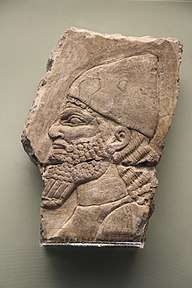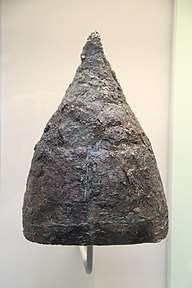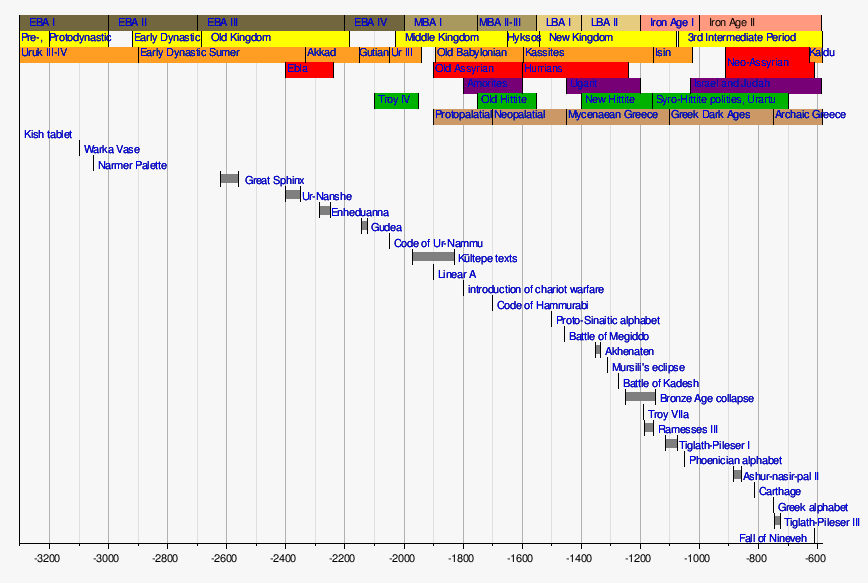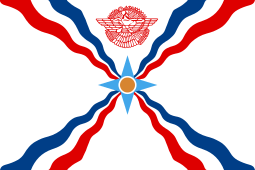Neo-Assyrian Empire
The Neo-Assyrian Empire (Assyrian cuneiform: ![]()
![]()
Neo-Assyrian Empire mat Aššur KI | |||||||||||||||||||
|---|---|---|---|---|---|---|---|---|---|---|---|---|---|---|---|---|---|---|---|
| 911 BC–609 BC | |||||||||||||||||||
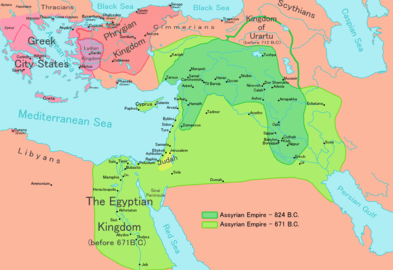 Map of the Neo-Assyrian Empire in 824 BC (dark green) and in its apex in 671 BC (light green) under King Esarhaddon | |||||||||||||||||||
| Capital | Aššur (911 BC) Kalhu (879 BC) Dur-Sharrukin (706 BC) Nineveh (705 BC) Harran (612 BC) | ||||||||||||||||||
| Common languages | Akkadian (official) Aramaic (official) Sumerian (declining) Hittite Hurrian Phoenician Egyptian | ||||||||||||||||||
| Religion | Polytheism | ||||||||||||||||||
| Government | Monarchy | ||||||||||||||||||
| King | |||||||||||||||||||
• 911–891 BC | Adad-nirari II (first) | ||||||||||||||||||
• 612–609 BC | Ashur-uballit II (last) | ||||||||||||||||||
| Historical era | Iron Age | ||||||||||||||||||
• Reign of Adad-nirari II | 911 BC | ||||||||||||||||||
• Battle of Nineveh | 612 BC | ||||||||||||||||||
| 609 BC | |||||||||||||||||||
| Area | |||||||||||||||||||
| 670 BC[1] | 1,400,000 km2 (540,000 sq mi) | ||||||||||||||||||
| |||||||||||||||||||
| Today part of | Iraq Syria Israel Turkey Egypt Sudan Saudi Arabia Jordan Iran Kuwait Lebanon Cyprus Palestine | ||||||||||||||||||
Following the conquests of Adad-nirari II in the late 10th century BC, Assyria emerged as the most powerful state in the world at the time, coming to dominate the Ancient Near East, East Mediterranean, Asia Minor, Caucasus, and parts of the Arabian Peninsula and North Africa, eclipsing and conquering rivals such as Babylonia, Elam, Persia, Urartu, Lydia, the Medes, Phrygians, Cimmerians, Israel, Judah, Phoenicia, Chaldea, Canaan, the Kushite Empire, the Arabs, and Egypt.[16][17]
The Neo-Assyrian Empire succeeded the Old Assyrian Empire (c. 2025–1378 BC), and the Middle Assyrian Empire (1365–934 BC) of the Late Bronze Age. During this period, Aramaic was also made an official language of the empire, alongside Akkadian.[18]
Upon the death of Ashurbanipal in 631 BC, the empire began to disintegrate due to a brutal and unremitting series of civil wars in Assyria proper. In 616 BC, Cyaxares, king of the Medes and Persians, made alliances with Nabopolassar, ruler of the Babylonians and Chaldeans, and also the Scythians and Cimmerians against Assyria. At the Fall of Harran (609 BC), the Babylonians and Medes defeated an Assyrian-Egyptian alliance, after which Assyria largely ceased to exist as an independent state. A failed attempt to reconquer Harran ended the Assyrian Empire.[19] Although the empire fell, Assyrian history continued; there are still Assyrians living in Iran, Iraq, and elsewhere, in the present day.[20]
Background
Assyria was originally an Akkadian kingdom which evolved in the 25th to 24th centuries BC. The earliest Assyrian kings such as Tudiya were relatively minor rulers, and after the founding of the Akkadian Empire, which lasted from 2334 BC to 2154 BC, these kings became subject to Sargon of Akkad, who united all the Akkadian- and Sumerian-speaking peoples of Mesopotamia (including the Assyrians) under one rule.
The urbanised Akkadian-speaking nation of Assyria emerged in the mid 21st century BC, evolving from the dissolution of the Akkadian Empire. In the Old Assyrian period of the Early Bronze Age, Assyria had been a kingdom of northern Mesopotamia (modern-day northern Iraq), competing for dominance initially with the Hattians and Hurrians of Asia Minor, and the ancient Sumero-Akkadian "city states" such as Isin, Ur and Larsa, and later with Babylonia which was founded by Amorites in 1894 BC, and often under Kassite rule. During the 20th century BC, it established colonies in Asia Minor, and under the 20th century BC King Ilushuma, Assyria conducted many successful raids against the states of the south.
Assyria fell under the control of the Amorite chieftain Shamshi-Adad I (c. 1809 – 1776 BC), who established a dynasty and was unusually energetic and politically canny, installing his sons as puppet rulers at Mari and Ekallatum[21] Following this it found itself under short periods of Babylonian and Mitanni-Hurrian domination in the 17th and 15th centuries BC respectively, followed by another period of power from 1365 BC to 1074 BC, that included the reigns of kings such as Ashur-uballit I, Tukulti-Ninurta I (r. 1244–1208 B.C.), and Tiglath-Pileser I.
Middle Assyrian Empire
.jpg)
Ashur-uballit extended Assyrian control over the rich farming lands of Nineveh and Arbela to the north.[22] Tiglath-Pileser controlled the lucrative caravan routes that crossed the fertile crescent from the Mediterranean to the Persian Gulf.[23] Much campaigning by Tiglath-Pileser and succeeding kings was directed against Aramaean pastoralist groups in Syria, some of whom were moving against Assyrian centers. By the end of the 2nd millennium BC, the Aramaean expansion had resulted in the loss of much Assyrian territory in Upper Mesopotamia.[22]
After the death of Tiglath-Pileser I in 1076 BC, Assyria was in comparative decline for the next 150 years. The period from 1200 BC to 900 BC was a Dark Age for the entire Near East, North Africa, Caucasus, Mediterranean and Balkan regions, with great upheavals and mass movements of people. Assyria was in a stronger position during this time than potential rivals such as Egypt, Babylonia, Elam, Phrygia, Urartu, Persia and Media.[24]
History
Adad-nirari II and Ashurnasirpal II (911–859 BC)
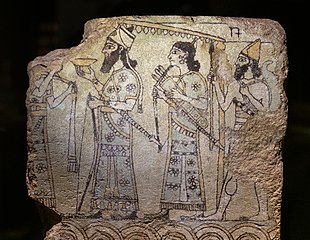
Beginning with the campaigns of Adad-nirari II, Assyria again became a great power, ultimately overthrowing the Twenty-fifth dynasty of Egypt and conquering Elam, Urartu, Media, Persia, Mannea, Gutium, Phoenicia/Canaan, Arabia, Israel, Judah, Philistia, Edom, Moab, Samarra, Cilicia, Cyprus, Chaldea, Nabatea, Commagene, Dilmun, Shutu and Neo-Hittites; driving the Nubians, Kushites and Ethiopians from Egypt; defeating the Cimmerians and Scythians; and exacting tribute from Phrygia among others. Adad-nirari II and his successors campaigned on an annual basis for part of every year with an exceptionally well-organized army.[21] He subjugated the areas previously under only nominal Assyrian vassalage, conquering and deporting Aramean and Hurrian populations in the north to far-off places. Adad-nirari II then twice attacked and defeated Shamash-mudammiq of Babylonia, annexing a large area of land north of the Diyala river and the towns of Hit and Zanqu in mid Mesopotamia. He made further gains over Babylonia under Nabu-shuma-ukin I later in his reign. He was succeeded by Tukulti-Ninurta II in 891 BC, who further consolidated Assyria's position and expanded northwards into Asia Minor and the Zagros Mountains during his short reign.
The next king, Ashurnasirpal II (883–859 BC), embarked on a vast program of expansion. During his rule, Assyria recovered much of the territory that it had lost around 1100 BC at the end of the Middle Assyrian period.[22] Ashurnasirpal II also campaigned in the Zagros Mountains in modern Iran, repressing a revolt against Assyrian rule by the Lullubi and Gutians. The Assyrians began boasting in their ruthlessness around this time. Ashurnasirpal II also moved his capital to the city of Kalhu (Calah/Nimrud). The palaces, temples and other buildings raised by him bear witness to a considerable development of wealth and art. Ashurnasirpal II introduced a policy of mass deportation of conquered people, which continued on a greatly increased scale under his son, Shalmaneser III.[26]
Shalmaneser III to Adad-nirari III (859–783 BC)
Ashurnasirpal's son, Shalmaneser III (859–824 BC), had a long reign of 35 years, in which the capital was converted into an armed camp. Each year the Assyrian armies marched out to campaign. Babylon was occupied, and Babylonia reduced to vassalage. He fought against Urartu and marched an army against an alliance of Aramean states headed by Hadadezer of Damascus and including Ahab, king of Israel, at the Battle of Qarqar in 853 BC. Despite Shalmaneser's description of 'vanquishing the opposition', it seems that the battle ended in a deadlock, as the Assyrian forces were withdrawn soon afterwards.
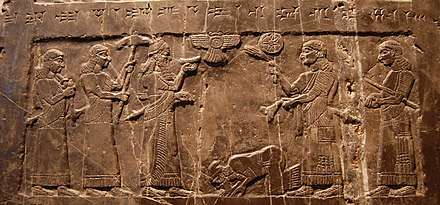
Shalmaneser took the neo Hittite state of Carchemish in 849 BC, and in 842 BC, marched an army against Hazael, King of Damascus, besieging the city and forcing tribute, but not taking it. In 841 BC, he also brought under tribute Jehu of Israel, and the Phoenician states of Tyre, and Sidon. His black obelisk, discovered at Kalhu, records many military exploits of his reign.[27]
The last four years of Shalmaneser's life were disturbed by the rebellion of his eldest son Ashur-nadin-aplu that nearly proved fatal to Assyria. Twenty seven cities, including Assur, Arbela, Arrapha (Kirkuk) and other places joined the pretender. The rebellion was not directed primarily against the king, but rather against the provisional governors such as Dayan-Ashur who had assumed disproportionate power. The revolt was quashed with difficulty by Shamshi-Adad V, Shalmaneser's second son, who succeeded him upon his death in 824 BC.
The long and bitter civil war had allowed the Babylonians to the south, the Medes, Manneans, the Persians to the north and east, the Arameans, and the Neo-Hittites in the west to largely shake off Assyrian rule, and Shamshi-Adad V spent the remainder of his reign reasserting control over those peoples. During this period, Urartu took the opportunity to reassert its influence on the region. As a result of all these events, Assyria did not expand further during the reign of Shamshi-Adad V. Adad-nirari III was a boy when succeeding his father in 811 BC, and for five years until 806 BC, his mother, Queen Sammuramat (also depicted as Semiramis) ruled as regent in his stead. Despite the numerous legends regarding this queen, she is mentioned little in Assyrian records of the time.
In 806 BC, Adad-nirari III took the reins of power. He invaded the Levant and subjugated the Arameans, Phoenicians, Philistines, Israelites, Neo-Hittites and Edomites. He entered Damascus and forced tribute upon its king Ben-Hadad III. He next turned to Iran, and subjugated the Persians, Medes and Manneans, penetrating as far as the Caspian Sea. His next targets were the Chaldean and Sutu tribes of southeastern Mesopotamia whom he conquered and reduced to vassalage.
Period of stagnation, 783–745 BC
Adad-nirari III died prematurely in 783 BC, and this led to a period of true stagnation. Shalmaneser IV (783–773 BC) seems to have wielded little authority, and a victory over Argishti I, king of Urartu at Til Barsip, is accredited to a general ('Turtanu') named Shamshi-ilu who does not even bother to mention his king. Shamshi-ilu also scored victories over the Arameans and Neo-Hittites, and again, takes personal credit at the expense of his king.
Ashur-dan III ascended the throne in 772 BC. He proved to be a largely ineffectual ruler who was beset by internal rebellions in the cities of Ashur, Arrapkha, and Guzana. He failed to make further gains in Babylonia and Aram (Syria). His reign was also marred by Plague and an ominous Solar Eclipse. Ashur-nirari V became king in 754 BC, but his reign seems to have been one of permanent revolution, and he appears to have barely left his palace in Nineveh before he was deposed by Tiglath-Pileser III in 745 BC, bringing a resurgence to Assyria.
Tiglath-Pileser III, 744–727 BC
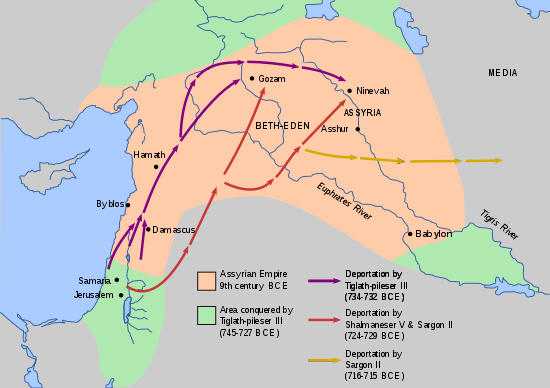
When Tiglath-Pileser III ascended the throne, Assyria was in the throes of a revolution. Civil war and pestilence were devastating the country, and many of Assyria's most northerly colonies in Asia Minor had been wrested from it by Urartu. In 746 BC, the city of Kalhu joined the rebels, but on the 13th of Iyyar in the following year, an Assyrian general (Turtanu) named Pulu seized the crown under the name of Tiglath-Pileser III, and made sweeping changes to the Assyrian government, considerably improving its efficiency and security.
The conquered provinces were organized under an elaborate bureaucracy, with the king at the head—each district paying a fixed tribute and providing a military contingent. The Assyrian forces at this time became a professional standing army. Assyrian policy was henceforth directed toward reducing the whole civilized world into a single empire, throwing its trade and wealth into Assyrian hands. These changes are often identified as the beginning of the "Second Assyrian Empire".
When Tiglath-Pileser III had ascended the throne of Assyria, he invaded Babylonia, defeated its king Nabonassar, and abducted the gods of Šapazza; these events are recorded in the Assyrian-Babylonian Chronicle.[28]
After subjecting Babylon to tribute, defeating Urartu and conquering the Medes, Persians and Neo-Hittites, Tiglath-Pileser III directed his armies into Aramea, of which large swathes had regained independence, and the commercially successful Mediterranean seaports of Phoenicia. He took Arpad near Aleppo in 740 BC after a siege of three years, and razed Hamath. Azariah, king of Judah had been an ally of the king of Hamath, and thus was compelled by Tiglath-Pileser to do him homage and pay yearly tribute.
Invasion of Israel (738 BC)
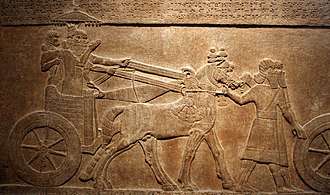
In 738 BC, during the reign of king Menahem of Israel, Tiglath-Pileser III occupied Philistia (modern-day southwestern Israel and the Gaza Strip) and invaded Israel, imposing on it a heavy tribute.[30] Ahaz, king of Judah, engaged in a war against Israel and Aramea, appealed for help to the Assyrian king by means of presents of gold and silver;[31] Tiglath-Pileser III accordingly "marched against Damascus, defeated and put king Rezin to death, and besieged the city itself". Leaving part of his army to continue the siege, he advanced, ravaging with fire and sword the provinces east of the Jordan (Nabatea, Moab and Edom), Philistia, and Samaria; and in 732 BC he took the chief Aramean state of Damascus, deporting many of its inhabitants and the Israelite inhabitants of Samaria to Assyria. He also forced tribute from the Arabs of the deserts in the Arabian peninsula.
In 729 BC, Tiglath-Pileser III went to Babylonia and captured Nabu-mukin-zeri, the king of Babylon.[32] He had himself crowned as King Pulu of Babylon. Tiglath-Pileser III died in 727 BC, and was succeeded by Shalmaneser V. However, King Hoshea of Israel suspended paying tribute, and allied himself with Egypt against Assyria in 725 BC. This led Shalmaneser to invade Syria[33] and besiege Samaria (capital city of Israel) for three years.[34]
Sargonid dynasty
Sargon II, 721–705 BC
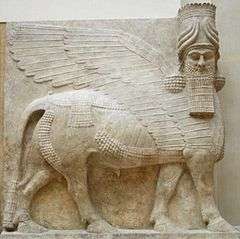
Shalmaneser V died suddenly in 722 BC, while laying siege to Samaria, and the throne was seized by Sargon II, the Turtanu (commander-in-chief of the army, which the Jewish sources record as Tartan), who then quickly took Samaria, effectively ending the northern Kingdom of Israel and carrying 27,000 people away into captivity into the Israelite diaspora.[35]
Sargon II waged war in his second year (721 BC) against the king of Elam, Humban-Nikash I, and his ally Marduk-apal-iddina II (the biblical Merodach-Baladan), the Chaldean ruler of Babylon, who had thrown off Assyrian rule,[36] but Sargon was unable to dislodge him on this occasion.[37] Sargon, able to contain the revolt but not actually retake Babylon on this occasion, turned his attention again to Urartu and Aramea, taking Carchemish in 717, as well as re-conquering the Medes, Persians and Manneans, penetrating the Iranian Plateau as far as Mount Bikni and building several fortresses. Urartu suffered a crushing defeat—its capital city was sacked and its king Rusas committed suicide in shame. The Neo-Hittite states of northern Syria were conquered, as well as Cilicia and Commagene.
Assyria was belligerent towards Babylonia for ten years while Marduk-apla-iddina ruled Babylon.[38] In 710 BC, Sargon attacked Babylonia and defeated Marduk-apla-iddina, who fled to his protectors in Elam.[39] As a result of this victory the Greek rulers of Cyprus gave allegiance to Assyria and king Midas of Phrygia, fearful of Assyrian power, offered his hand in friendship. Sargon also built a new capital at Dur Sharrukin ("Sargon's City") near Nineveh, with all the tribute Assyria had collected from various nations.
Sennacherib, 705–681 BC
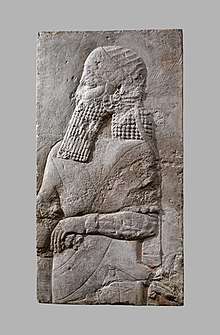
In 705 BC, Sargon was killed in battle while driving out the Cimmerians, who had come down from their homeland on the shores of the Black Sea and attacked the Assyrian-ruled colonies and peoples in Iran, forcing its Persian subjects southwards from their original lands around Urmia. He was succeeded by his son Sennacherib.[40]
His first task was to affirm his control over Cilicia, which was attempting to rebel with Greek help. Sennacherib marched into Cilicia, defeating the rebels and their Greek allies. He also reasserted Assyria's mastery of Corduene in Asia Minor.
Sennacherib decided to move the capital from Sargon's Dur-Sharrukin to the city of Nineveh, and in Nineveh he built the famous "the Palace without a Rival", he made Nineveh a beautiful city and improved the city, planting orchards and gardens.[15]
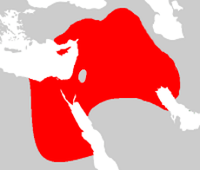
The Egyptians had begun agitating peoples within the Assyrian empire in an attempt to gain a foothold in the region. As a result, in 701 BC, Hezekiah of Judah, Lule king of Sidon, Sidka, king of Ascalon and the king of Ekron formed an alliance with Egypt against Assyria. Sennacherib attacked the rebels, conquering Ascalon, Sidon and Ekron and defeating the Egyptians and driving them from the region. He marched toward Jerusalem, destroying 46 towns and villages (including the heavily defended city of Lachish) in his path. This is graphically described in Isaiah 10; exactly what happened next is unclear (the Bible says an angel of the Lord killed 185,000 Assyrian soldiers at Jerusalem after Hezekiah prayed in the temple).[41] Sennacherib's account says Judah paid him tribute and he left.
The Hebrew Bible states that Hezekiah did pay tribute once, and the Assyrians left, but returned a second time when the soldiers were then killed; however what is certain is that Sennacherib failed to actually capture Jerusalem. Marduk-apla-iddina had returned to Babylonia during the reign of Sennacherib. The Assyrian king attacked him in 703 BC outside Kish and defeated him. Sennacherib plundered Babylonia and pursued Marduk-apla-iddina through the land. At his return to Assyria, Sennacherib installed a puppet ruler, Bel-ibni, as king of Babylon.[42] Bel-ibni, however, committed hostilities, so Sennacherib returned to Babylon in 700 BC and captured him and his officers. Sennacherib instead installed his own son Ashur-nadin-shumi on the throne of Babylon.[43]
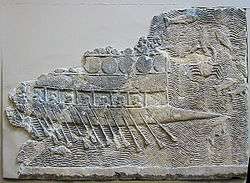
Sennacherib launched a campaign against Elam in 694 BC and ravaged the land. In retaliation, the king of Elam attacked Babylonia. Ashur-nadin-shumi was captured and brought back to Elam and a new king called Nergal-ushezib was installed as ruler of Babylon.[44] The Assyrians returned the next year to Babylonia and plundered the gods of Uruk. Nergal-ušezib and his Elamite allies were defeated by Assyria, and he was taken prisoner and transported to Assyria.[45] Another native ruler, called Mushezib-Marduk, soon seized the throne of Babylon. He held on to it with help of his Elamite allies for four years until 689 BC, when the Assyrians retook the city.[46] Sennacherib responded swiftly by opening the canals around Babylon and flooding the outside of the city until it became a swamp, resulting in its destruction, and its inhabitants were scattered.
In 681 BC, Sennacherib was murdered while praying to the god Nisroch by one or more of his own sons (allegedly named Adremelech, Abimlech, and Sharezer), perhaps as retribution for his destruction of Babylon.[47][48]
Esarhaddon, 681–669 BC
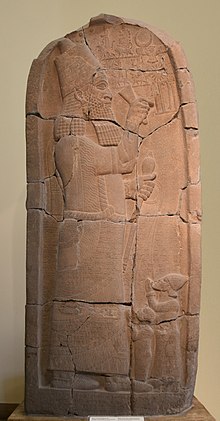
Sennacherib was succeeded by his son Esarhaddon (Ashur-ahhe-iddina), who had been governor of Babylonia; at the time of his father's murder he was campaigning in the Caucasus Mountains against Urartu, where he won a victory at Malatia (Milid). During the first year of Esarhaddon's rule, a rebellion broke out in the south of Babylonia. Nabu-zer-kitti-lišir, an ethnic Elamite governor of the mat Tamti, with the help of the Chaldeans, laid siege to Ur. The Elamite and his Chaldean allies were defeated and he fled to his kinsmen in Elam (Hal-Tamti); however, "the king of Elam took him prisoner and put him to the sword" (ABC 1 Col.3:39–42); also in (ABC 14:1–4).
In 679 BC the Cimmerians and Scythians (a horse-riding horde from what is now southern Russia) crossed the Taurus Mountains and harassed Assyrian colonies in Cilicia. Esarhaddon swiftly attacked and drove these marauders away.
As king of Assyria, Esarhaddon immediately had Babylon rebuilt. Defeating the Scythians, Cimmerians and Medes (again penetrating to Mt. Bikni), he then turned his attention westward to Phoenicia—now allying itself with the Nubian/Kushite rulers of Egypt against him—and sacked Sidon in 677 BC. He also captured King Manasseh of Judah and kept him prisoner for some time in Babylon (2 Chronicles 33:11). Having had enough of Egyptian meddling, Esarhaddon raided Egypt in 673 BC. Two years later he launched a full invasion and conquered Egypt, chasing the Pharaoh Taharqa back to Nubia, thus bringing to an end Nubian-Kushite rule in Egypt, and destroying the Kushite Empire which had begun in 760 BC.
The Babylonian Chronicles retells how Egypt "was sacked and its gods were abducted".[49] The pharaoh Tirhakah fled Egypt, and a stele commemorating the victory, was set up at Sinjerli in Asia Minor, north of the Gulf of Antioch; it is now in the Pergamon Museum, Berlin. The Bible graphically recounts Egypt's demise in Isaiah 20:4 "So shall the king of Assyria lead away the Egyptians prisoners, and the Ethiopians captives, young and old, naked and barefoot, even with their buttocks uncovered, to the shame of Egypt. 5 And they shall be afraid and ashamed of Ethiopia their expectation, and of Egypt their glory."
Assyria defeated Urartu, annexed much of its territory and reduced it to vassalage, and expanded southwards as far as Dilmun (Bahrain) and into Arabia at this time. This was perhaps Assyria's greatest territorial extent.[15]
However, the Assyrian governors and local puppet rulers Esarhaddon had appointed over Egypt were obliged to flee the restive native populace who yearned for independence now that the Kushites and Nubians had been ejected.
A new campaign was launched by Esarhaddon in 669 BC. However, he became ill on the way and died. His elder son Shamash-shum-ukin became king of Babylon and his son Ashurbanipal became king of Assyria, with Ashurbanipal holding the senior position and Babylon subject to Nineveh.[50] Bel and the gods of Babylonia returned from their exile in Assur to Babylon in the first year of Shamash-shum-ukin's reign, and the akitu festival could be celebrated for the first time in twenty years.[51]
Ashurbanipal, 668–631 BC
%2C_c._645-635_BC%2C_British_Museum_(16722368932).jpg)
Ashurbanipal, or "Ashur-bani-apli" (Ashurbanapli, Asnapper), succeeded his father Esarhaddon to the throne. He continued to campaign in and to dominate Egypt, when not distracted by having to deal with pressures from the Medes to the east, and Cimmerians and Scythians to the north of Assyria. He installed a native Egyptian Pharaoh, Psammetichus, as a vassal king in 664 BC. However, after Gyges of Lydia's appeal for Assyrian help against the Cimmerians was rejected, Lydian mercenaries were sent to Psammetichus. By 652 BC, this vassal king was able to declare outright independence from Assyria with impunity, particularly as Ashurbanipal's older brother, Shamash-shum-ukin of Babylon, became infused with Babylonian nationalism, and began a major civil war in that year. However, the new dynasty in Egypt wisely maintained friendly relations with Assyria.
Shamash-shum-ukin attempted to raise a huge rebellion encompassing many vassal peoples against Ashurbanipal; however, this largely failed. This rebellion lasted until 648 BC, when Babylon was sacked, and Shamash-shum-ukin set fire to the palace, killing himself. Ashurbanipal then set about punishing the Chaldeans, Arabs and Nabateans who had supported the Babylonian revolt. He invaded the Arabian Peninsula and routed and subjugated the Arabs, including the powerful Qedar tribe, taking much booty back to Nineveh and killing the Arab kings, Abiate and Uate. The Nabateans who dwelt south of the Dead Sea and in northern Arabia, and the Chaldeans in the far south east of Mesopotamia were also defeated and subjugated. Elam was the next target; it was attacked in 646 and 640 BC, and its capital Susa sacked.

After the crushing of the Babylonian revolt Ashurbanipal appeared master of all he surveyed. To the east, Elam was devastated and prostrate before Assyria, the Manneans and the Iranian Persians and Medes were vassals. To the south, Babylonia was occupied, the Chaldeans, Arabs, Sutu and Nabateans subjugated, the Nubian empire destroyed, and Egypt paid tribute. To the north, the Scythians and Cimmerians had been vanquished and driven from Assyrian territory, Urartu, Phrygia, Corduene and the neo Hittites were in vassalage, and Lydia pleaded for Assyrian protection. To the west, Aramea (Syria), the Phoenicians, Israel, Judah, Samarra and Cyprus were subjugated, and the Hellenised inhabitants of Caria, Cilicia, Cappadocia and Commagene paid tribute to Assyria.
Assyria now appeared stronger than ever. However, his long struggle with Babylonia and Elam and their allies, and the constant campaigning to control and expand its vast empire in all directions, left Assyria exhausted. It had been drained of wealth and manpower; the devastated provinces could yield nothing to supply the needs of the imperial exchequer, and it was difficult to find sufficient troops to garrison the huge empire.
Assyria, therefore, was ill-prepared to face the renewed hordes of Scythians who now began to harass the frontiers to the north and north east. After the Assyrians destroyed Elam, the Medes had begun to grow powerful, becoming the dominant force among the Iranian peoples who had begun to settle the regions to the east of Mesopotamia circa 1000 BC at the expense of the Persians and the pre-Iranian Elamites and Manneans, and they were by the end of Ashurbanipal's reign only nominally under Assyrian vassalage. Asia Minor too was full of hostile Scythians and Cimmerians who had overrun Urartu, Lydia and Phrygia, before being driven back by the Assyrians. However, while Ashurbanipal lived, he was able to contain these potential threats.
Fall of Assyria, 631–609 BC

The empire began to disintegrate rapidly after a series of bitter civil wars broke out involving a number of claimants to the throne. Ashur-etil-ilani succeeded Ashurbanipal, but his reign was short and he was succeeded in 627 BC by his brother Sinsharishkun. After dealing with the revolt of the general Sin-shumu-lishir, Sinsharishkun faced a much larger threat. His Babylonian vassal state had taken advantage of the upheavals in Assyria and rebelled under the previously unknown Nabopolassar, a member of the Chaldean tribe, in 625 BC. What followed was a long war fought in the Babylonian heartland. Nabopolassar tried to capture Nippur, the main Assyrian center of power in Babylonia, but was defeated by Sinsharishkun. However, Nabopolassar did take the actual city of Babylon after a popular uprising there, and was crowned king of the city in 625 BC.
Sinsharishkun then lost more ground, before he succeeded in recapturing Uruk in about 624 BC, only to quickly lose it again. When Sinsharishkun led a large army to Babylonia in 623 BC, in an attempt to finally crush the rebellion, yet another war broke out in the Assyrian homeland. A relief army was sent back from the Babylonian campaign but changed sides, thereby allowing the usurper to reach the capital, Nineveh, without interference, and claim the throne. Sinsharishkun was able to quell the homeland rebellion, but precious time was lost to solve the Babylonian problem, and Nabopolassar was able to consolidate his position.
In 620 BC, Nabopolassar finally captured Nippur, becoming master of Babylonia. While these events were unfolding, the Medes had also freed themselves from Assyrian domination and consolidated power in what was to become Persia. In 616 BC, Cyaxares, the Median king, made an alliance with Nabopolassar, and with the help of the Scythians and Cimmerians, attacked Assyria. Assyria now faced overwhelming odds, and after four years of bitter fighting, the coalition destroyed Nineveh in 612 BC, after a three-month siege, followed by house-to-house fighting. Sinsharishkun was killed in the process, and the Fall of Nineveh marked the beginning of the end of the Assyrian Empire.
A general called Ashur-uballit II was declared king of Assyria, and with belated military support from the Egyptian pharaoh Necho II, whose dynasty had been installed with the help of the Assyrians, held out at Harran until 609 BC.[52] Egyptian aid continued to the Assyrians, who desperately attempted to curb the increasing power of the Babylonians and Medes.
In 609 BC, at the Battle of Megiddo, an Egyptian force defeated a Judean force under king Josiah and managed to reach the last remnants of the Assyrian army. In a final battle at Harran in 609 BC, the Babylonians and Medes defeated the Assyrian-Egyptian alliance, after which Assyria ceased to exist as an independent state.[52] It is not known if Ashur-uballit II was killed at Harran or if he survived; anyway, he subsequently disappeared from the pages of history. In 605 BC, another Egyptian force fought the Babylonians (Battle of Carchemish), helped by the remnants of the army of the former Assyria, but this too met with defeat.
In the mid-6th century BC, Babylonia and Assyria became provinces of the Persian Empire. In 520 BC, Assyria made a final attempt to regain independence, with a large-scale rebellion against the Achaemenid Empire, which was suppressed by king Darius the Great.
Though the Assyrians during the reign of Ashurbanipal destroyed the Elamite civilization, the Assyrians' culture did influence the succeeding empires of the Medes and the Persians, Indo-Iranian peoples who had been dominated by Assyria.[53]
Environmental factors
A.W. Schneider and S.F. Adah have suggested that increased population coupled with severe drought contributed to significant economic and political instability.[54][55] Conquered peoples were often deported great distances and resettled in Assyrian provinces to minimize the possibility of revolts.[21] The Assyrian heartland had undergone a population explosion during the late 8th and early 7th centuries, largely due to the forced resettlement of conquered peoples into the empire. However, a study on mineral deposits in two stalagmites taken from northern Iraq's Kuna Ba Cave, indicates to a shift from a wet climate to a dry one between 675 and 550 B.C., which might have contributed to the fall of Neo-Assyrian Empire.[56]
Assyria after the fall
After its fall, Assyria came to be ruled by the Median Empire as Athura for a short period. Ironically, Nabonidus, the last king of Babylon, was Assyrian, originating from Harran, as was his son Belshazzar. After this it was ruled by Achaemenid Persia (Assyria revolted against Persia in 520 BC[57]), the Greek Seleucid kings, then again by various Persian dynasties, Sassanids, Parthians, etc. For a brief period under Trajan, it was ruled by Rome.
Assyria survived as an entity, a subject province. The name survived also in various forms (Athura, Asuristan, Roman Province of Assyria, Seleucid Syria, etc.) and the land was recognised as such by the Persians, Greeks, Romans, Armenians, Georgians and Byzantines. After the Arab conquest of the late 7th century AD the province of Assyria was finally dissolved.
Assyrian culture survived; Assyrio-Babylonian gods were worshipped well into Christian times, as late as the 4th century AD , and temples were still being dedicated to the god Ashur in his home city in the late 3rd century AD. A number of kingdoms that had Assyrian identity, such as Assur, Hatra, Osrhoene and Adiabene, sprung up in Assyria between the 2nd century BC and 4th century AD.[58] Christianity took hold between the 1st and 3rd centuries AD, and Parthian and Sassanid Assyria (Asuristan) became the center of the Assyrian Church of the East, Syriac Christianity and Syriac literature (the term "Syria" being an Indo-European (Luwian) corruption of "Assyria" adopted by the Greeks),[59] where it still survives.
Role of Aramaic
Tiglath Pileser III made Aramaic the lingua franca of the empire, originally the language of the Arameans. Aramaic was easier to write than Akkadian, so older documents collected by Assyrian kings were translated from Akkadian into Aramaic, and newer ones were written in Aramaic and ignored the Akkadian.[60] Aramaic was the common language of the people and traders, but the official government language was the Neo-Assyrian dialect of Akkadian. By the 6th century, Aramaic had marginalised the Akkadian language so much that Aramaic came to be the imperial language of Achaemenid Assyria. One of the key factors contributing to the use of Aramaic was the rise and fall of Assyria; during its rule, deportations, colonisations, and intermarriage increased contact between Arameans and Assyrians.
In effect the populations of both Assyria and Babylonia had become an ethnic mix of native Akkadians and Arameans. Even though Aramaic was the common tongue of the empire, Akkadian continued to be the preferred language of royalty and the elites.[26] Rulers, royalty and elites were all trained to speak both Aramaic and Akkadian until, by the 7th century BC, the ruling class was fully bilingual.[26] The rest of the empire was divided into two sects: those who spoke Aramaic and those who spoke Akkadian. Generally, the common people and traders were also bilingual but Aramaic continued to dominate the empire outside Assyria proper.[26] As the Empire fell, only the elite knew how to read and write the Akkadian script. The savage sacking of Nineveh and Assur, as well as numerous other Assyrian cities, ensured that few of these elites survived to pass on the language, but some cities such as Arrapkha were spared the destruction.
Akkadian survived the fall of Assyria; the last recorded writings in Akkadian cuneiform date from the 1st century AD, and writings in Akkadian (but in the Aramaic/Syriac script) date as late as the 3rd century AD.
Administration
The Assyrian empire expanded through establishing provinces and vassal states.[61] Many of these lands were under control by members of the king's court. Most of these offices had names that were titular, but holders of these offices may have enacted their namesakes in ceremonial manners.[62]
The provinces were a form of territorial control and were made up of the capital city, farming villages, road stations, outposts, and garrisons. The province itself was managed by the provincial governor, who also had militaristic duties like gathering and reporting military intelligence, or leading Assyrian armies in battle. As governors, they only answered to the king, and certain officials of the king's high court. A state communication system, consisting of mule riders travelling in royal road with change stations within certain intervals, allowed the imperial court to communicate efficiently with the governors.[63] Those directly beneath the governors were their deputy governors, and they oversaw a number of auxiliary officials like bureaucrats, scribes, and accountants. The lowest rank in the provincial government were the village managers who mostly supervised local farming efforts and projects.[61]
The vassal states were under hegemonic control and these were territories gained through a show of military dominance – by either forcing their way through or proving that they could. Those who submitted peacefully remained relatively autonomous and their ruling elites were permitted to stay in power. Those who resisted were overthrown and had their rulers replaced with puppet officials loyal to Assyria. The terms for vassalage were that the vassal state was to pay Assyria tribute in the form of goods, labor, and soldiers in exchange for military protection. The protection provided by Assyria seemed to suit the needs of Assyria more than the needs of the vassal states, as Assyria have used a perceived threat toward a vassal state as an excuse to invade nearby settlements, and the vassal states have also been left to fend for themselves.[61]
Assyrians invented a new way of dealing with conquered people. After conquering a land, its people would be resettled to other areas within the empire, with land and state assistance. This policy was used to create a uniform population, although it produced some hotbeds of dissent. By the 7th century BC, the royal entourage included scholars, craftsmen and singers from Babylonia, Anatolia, Egypt, and Iran.[64]
Army
The Assyrian empire has been described as the "first military power in history".[65] Mesopotamia was the site of some of the earliest recorded battles in history.[66][67]
The Assyrian army's hierarchy was typical of the Mesopotamian armies at the time. The King whose rule was sanctioned by the gods, would be the commander of the entire army of the Empire. He would appoint senior officers on certain occasions to campaign in his place if his presence on the battlefield could or had to be spared.[68] The Neo-Assyrian Empire took advantage of many different types and styles of militaristic vessels and engines for warfare. This includes chariots, cavalry, and siege engines.
.jpg) Tiglath-Pileser III besieging a town with siege engines
Tiglath-Pileser III besieging a town with siege engines Assyrian king on a chariot
Assyrian king on a chariot Assyrian military in Southern Meospotamia
Assyrian military in Southern Meospotamia Beheaded enemies in Southern Mesopotamia
Beheaded enemies in Southern Mesopotamia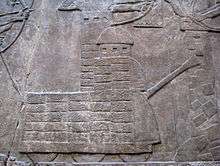 Assyrian battering ram
Assyrian battering ram
Society
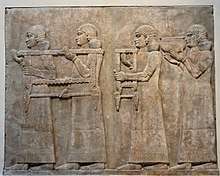
The Neo-Assyrian Empire was a warlike society with an expansionist ideology and, as a result of their constant expansion, they acquired a diverse and multi-ethnic empire. One Assyrian identity did not happen until, ironically, Ashurnasirpal II began deporting people from the empire. The majority of the displaced peoples were settled in the urban heart of the empire bringing with them what would become the common language: Aramaic, the first unifying factor.[26] The spreading of Aramaic is known as the Aramaization period and soon the new language would become the common language as well as the imperial language. As the people settled in the new land, they became exposed to Assyrian cultural ideas such as "royal ideologies, religious ideas and mythologies..." and it "was incessantly propagated to all segments of the population through imperial art, emperor cult, religious festivals, and the cults of Aššur, Ištar, Nabû, Sîn and other Assyrian gods."[26] This was a process known as "Assyrianization."[26] The process of Assyrianization was a gradual process that occurred through generations of intermarriages, military participation, and daily interaction with Assyrian people (those who were not descended from the deportees generations earlier).[26] Through the generations of cultural and linguistic exchange there came to be a homogenous Assyrian identity.
Eunuchs in elite society
Eunuchs often filled roles as servants to the kings and accompanied him in almost all aspects of ruling, such as administrative duties and rituals.[69] Royal eunuchs were regularly promoted to being provincial governors and they could rule the lands as they saw fit; they could "erect their own steles, place their names before that of the king's, and grant zakatu (tax-free status) to their subjects."[69] As governors of their own lands, they had the right to declare war on other governances and collect any tribute that may have resulted from the battles.[69]
Culture
(circa 650 BC)
Several of the most ancient works of Mesopotamian literature are best preserved in Neo-Assyrian copies. Thus, there are 7th-century copies of both the Epic of Gilgamesh and the Enûma Eliš from Ashurbanipal's library in Nineveh, as well as Neo-Assyrian versions of the Atra-Hasis.
Neo-Assyrian cuneiform is the final stage of the long evolution of the cuneiform script. The number of glyphs was reduced, and the glyph shapes were standardized and simplified, so that modern cuneiform sign inventories are usually based on the Neo-Assyrian glyph shapes. Neo-Assyrian cuneiform remained in use alongside the Aramaic alphabet well into Parthian times. The Aramaic language from the 8th century BC was adopted as the Lingua Franca of the Assyrian Empire and continued by the Achaemenid Empire. Assyrian scribes are often depicted in pairs: one writing in Akkadian on the cuneiform tablet, the other writing in Aramaic on the parchment or papyrus.
The main cities that existed in Assyria itself were Nineveh, Ashur, Kalhu (Calah, Nimrud), Sippar, Opis, Arrapha (Kirkuk), Harran, Arbela (Erbil) and Ekallatum. Outside of Assyria proper, major cities at various times under Assyrian domination were Babylon, Damascus (Dimashq), Thebes, Memphis, Tyre, Sidon, Ecbatana, Hattusa, Jerusalem, Susa, Persepolis, Carchemish, Sardis, Ur, Uruk, Nippur and Antioch.
At the end of the Bronze Age, Nineveh was much smaller than Babylon, but still one of the world's major cities (population about 33,000). By the end of the Neo-Assyrian period, it had grown to a population of some 120,000, and was possibly the largest city of that time.
All free male citizens were obliged to serve in the army for a time, a system which was called the ilku-service. The Assyrian law code was compiled during this period.
See also
| Iron Age |
|---|
| ↑ Bronze Age |
|
Ancient Near East (1200–550 BC)
|
|
Iron Age metallurgy |
↓ Ancient history
|
| Historiography |
- Timeline of the Assyrian Empire
- Mesopotamian Religion
- Military history of the Neo-Assyrian Empire
Notes
- Sumero-Akkadian: 𒆳𒀭𒊹𒆠 KUR AN-ŠAR2KI; the same in Assyrian cuneiform in Ashubanipal's Rassam cylinder:

.jpg)


References
- Taagepera, Rein (1979). "Size and Duration of Empires: Growth-Decline Curves, 600 B.C. to 600 A.D". Social Science History. 3 (3/4): 121. doi:10.2307/1170959. JSTOR 1170959.
- Name used in Neo-Babylonian inscriptions, such as the Rassam cylinder of Ashurbanipal
- Rassam cylinder transcription in "CDLI-Archival View". cdli.ucla.edu.
- "The country of Assyria, which in the Assyro-Babylonian literature is known as mat Aššur (ki), “land of Assur,” took its name from the ancient city of Aššur" in Encyclopædia Britannica, Volume II Slice VII - "Assur" entry. 1911.
- "rinap/rinap4". oracc.museum.upenn.edu.
- "The name Anshar, softened into Aushar, and subsequently into Ashshur, was first applied to the town and then to the whole country" in Sayce, A. H. (2005). History of Egypt, Chald_a, Syria, Babylonia, and Assyria, Volume 6 (of 12). Library of Alexandria. p. 223. ISBN 978-1-4655-4330-1.
- Pongratz-Leisten, Beate (2015). Religion and Ideology in Assyria. Walter de Gruyter GmbH & Co KG. p. 110. ISBN 978-1-61451-426-8.
- Quentin, A. (1895). "INSCRIPTION INÉDITE DU ROI ASSURBANIPAL: COPIÉE AU MUSÉE BRITANNIQUE LE 24 AVRIL 1886". Revue Biblique (1892-1940). 4 (4): 554. ISSN 1240-3032.
- "Sumerian dictionary entry: Aššur [ASSYRIA] (GN)". oracc.iaas.upenn.edu.
- A Companion to Assyria : page 192
- The Cambridge Ancient History "The fall of Assyria (635–609 B.C.)"
- Encyclopaedia Britannica "The Median army took part in the final defeat of the Assyrians in northern Mesopotamia (612–609); and, when the territory of Assyria was divided between Media and Babylonia, Media took Assyria with Harran."
- "10 FACTS ON THE ANCIENT ASSYRIAN EMPIRE OF MESOPOTAMIA". Anirudh.
- Pollard, Elizabeth; Tignor, Robert; Rosenberg, Clifford (2015). Worlds Together, Worlds Apart. W.W. Norton & Company. p. 128. ISBN 978-0-393-92207-3.
- "Neo-Assyrian Empire". Joshua J. Mark.
- "Assyrian Eponym List". Retrieved 23 November 2014.
- Tadmor, H. (1994). The Inscriptions of Tiglath-Pileser III, King of Assyria, p.29
- Frye, Richard N. (1992). "Assyria and Syria: Synonyms". Journal of Near Eastern Studies.
And the ancient Assyrian empire, was the first real, empire in history. What do I mean, it had many different peoples included in the empire, all speaking Aramaic, and becoming what may be called, "Assyrian citizens." That was the first time in history, that we have this. For example, Elamite musicians, were brought to Nineveh, and they were 'made Assyrians' which means, that Assyria, was more than a small country, it was the empire, the whole Fertile Crescent.
- Frahm, Eckart (2017-06-12). A Companion to Assyria. John Wiley & Sons. p. 192. ISBN 9781444335934.
- "Assyria". Joshua J. Mark.
- "Neo-Assyria", Colorado State University
- "Assyria, 1365–609 B.C." in Heilbrunn Timeline of Art History Department of Ancient Near Eastern Art, The Metropolitan Museum of Art, New York, (originally published October 2004, last revised April 2010,)
- Boardman, John and Edwards I. E. S., The Cambridge Ancient History, Cambridge University Press, 1982 ISBN 9780521224963
- Roux, pp.282–283.
- "Tile British Museum". The British Museum.
- Parpola, Simo (2004). "National and Ethnic Identity in the Neo-Assyrian Empire and Assyrian Identity in Post-Empire Times" (PDF). Journal of Assyrian Academic Studies. 18 (2).
- "Black Obelisk, K. C. Hanson's Collection of Mesopotamian Documents". K.C. Hansen. Retrieved 23 November 2014.
- ABC 1 Col.1:5
- Jones, Clifford M. (1971). Old Testament Illustrations. CUP Archive. p. 77.
- 2 Kings 15:19
- 2 Kings 16:8
- ABC 1 Col.1:21
- 2 Kings 17:5
- ABC 1 Col.1:27
- 2 Kings 17:1–6, 24; 18:7, 9
- 2 Kings 20:12
- ABC 1 Col.1:31–37
- ABC 1 Col.1:41–42
- ABC 1 Col.2:1–3
- 2 Kings 18:13; 19:37; Isa. 7:17, 18
- II Kings 18–19
- ABC 1 Col.2:12–23
- ABC 1 Col.2:26–31
- ABC 1 Col.2:36–45
- ABC 1 Col.2:46 – Col.3:6
- ABC 1 Col.3:13–24
- Dalley, Stephanie (2007-11-29). Esther's revenge at Susa. pp. 63–66. ISBN 9780199216635.
- According to 2 Kings 19:37, while praying to the god Nisroch, he was killed by two of his sons, Adramalech, and Sharezer, and both of these sons subsequently fled to Urartu; this is repeated in Isaiah 37:38 and alluded to in 2 Chronicles 32:21.
- ABC 1 Col.4:25; also in ABC 14:28–29
- ABC 1 Col.4:30–33 and ABC 14:31–32, 37
- ABC 1 14:34–39 and ABC 1 Col.4:34–36
- Grant, R G. Battle a Visual Journey Through 5000 Years of Combat. London: Dorling Kindersley, 2005 pg 19
- Hirad Dinavari. "More alike than different". The Iranian.
The cultural give and take influenced the many things some of which are the cuneiform writing and the building of ziggurats which the later Assyrians and the Achaemenid (Hakhamaneshi) Persians inherited. The Assyrians for the most part were responsible for the destruction of the Elamite civilization but the Assyrians influenced the cultures of Media and Urartu and the influence of Elam lived on among the Medes and Persians. The various Iranian speaking peoples who had been coming into what is now Caucasus Iran, Afghanistan and Central Asia since around 4 thousand BCE were heavily influenced by the aboriginal Elamites and the Semitic Babylonians and Assyrians. This difference can be most noticed when one compares other Iranian speaking peoples who lived in Eurasia like the Scything and Sarmatians whose culture was very different with that of Iranian tribes who settled in the Iranian Plateau and became more intertwined with Slavic peoples. So from that far back Iran (the geographic location) has been multi-ethnic.
- Schneider, Adam W.; Adalı, Selim F. (2014). ""No harvest was reaped": demographic and climatic factors in the decline of the Neo-Assyrian Empire". Climatic Change. 127 (3–4): 435–446. doi:10.1007/s10584-014-1269-y. hdl:10.1007/s10584-014-1269-y.
- Schuster, Ruth. "Assyrian Empire was destroyed by drought and crowding, study says", Haaretz April 11, 2015
- Sinha, Ashish; Kathayat, Gayatri; Weiss, Harvey; Li, Hanying; Cheng, Hai; Reuter, Justin; Schneider, Adam W.; Berkelhammer, Max; Adalı, Selim F.; Stott, Lowell D.; Edwards, R. Lawrence (2019). "Role of climate in the rise and fall of the Neo-Assyrian Empire". Science Advances. 5 (11): eaax6656. doi:10.1126/sciadv.aax6656. PMC 6853769. PMID 31763452.
- Parpola, Simo (1999-09-04). "Assyrians after Assyria". University of Helsinki.
- "National and Ethnic Identity in the Neo-Assyrian Empire and Assyrian Identity in Post-Empire Times". Simo Parpola. p. 20.
When the Seleucid Empire disintegrated at the end of the second century BC, its western remnants were annexed to Rome, while several semi-independent kingdoms of decidedly Assyrian stamp and/or identity (Osrhoene, Adiabene, Hatra, Assur) popped up in the East under Parthian overlordship. These kingdoms perpetuated Assyrian cultural and religious traditions but were also receptive to Christianity, whose central ideas were in line with the central tenets of Assyrian religion and ideology, and which was felt as intrinsically Assyrian because of the Aramaic affinity of Jesus and the disciples.
- http://www.aina.org/articles/ttaasa.pdf
- "Assyria". Joshua J. Mark.
- Parker, Bradley J. The Mechanics of Empire: The Northern Frontier of Assyria as a Case Study in Imperial Dynamics. University of Helsinki: The Neo-Assyrian Text Corpus Project. 2001.
- Mattila, Raija. The King’s Magnates: A Study of the Highest Officials of the Neo-Assyrian Empire. University of Helsinki: The Neo-Assyrian Text Corpus Project. 2000.
- Radner, Karen (2012). "The King's Road – the imperial communication network". Assyrian empire builders. University College London.CS1 maint: ref=harv (link)
- Adam Hart-Davis, History: the Definitive Visual Guide: from the Dawn of Civilization to the Present Day (New York: DK Pub., 2012), p.80)
- Burenhult, Göran. Bra böckers encyklopedi om människans historia. 5, Civilisationens vaggor: tidiga högkulturer i esopotamien, Egypten och Asien (in Swedish). p. 37. ISBN 91-7133-171-9. OCLC 186397556.
Assyrien har med rätta kallats världens första militärmakt.
- Grant, R.G. (2005). Battle a Visual Journey Through 5000 Years of Combat. London: Dorling Kindersley. p. 12.
- Grant, R.G. (2005). Battle a Visual Journey Through 5000 Years of Combat. London: Dorling Kindersley. p. 13.
- Healy, The Ancient Assyrians, p. 19
- N'Shea, Omar; Omar, N'Shea. "Royal Eunuchs and Elite Masculinity in the Neo-Assyrian Empire". Near Eastern Archaeology. 79.
- Krejci, Jaroslav (1990). Before the European Challenge: The Great Civilizations of Asia and the Middle East. SUNY Press. p. 34. ISBN 978-0-7914-0168-2.
- Women and their Agency in the Neo-Assyrian Empire, Saana Teppo, Master's Thesis, April 2005. University of Helsinki, Faculty of Arts, Institute for Asian and African Studies, Assyriology.
Sources
- Roux, Georges (1982) Ancient Iraq, (Penguin, Harmondsworth)
External links
- http://www3.uakron.edu/ziyaret/historical.html
- https://www.webcitation.org/query?url=http://www.geocities.com/garyweb65/neoassy.html&date=2009-10-25+22:30:02
- http://www.britannica.com/eb/article-55456/history-of-Mesopotamia
- Chart of World Kingdoms, Nations and Empires – All Empires
- Lanfranchi, Giovanni B., "The Expansion of the Neo-Assyrian Empire and itsperipheries: Military, Political and Ideological Resistance"
- BetBasoo, Peter. "Brief History of Assyrians", Assyrian International News Agency
